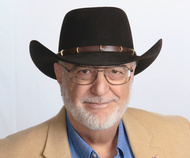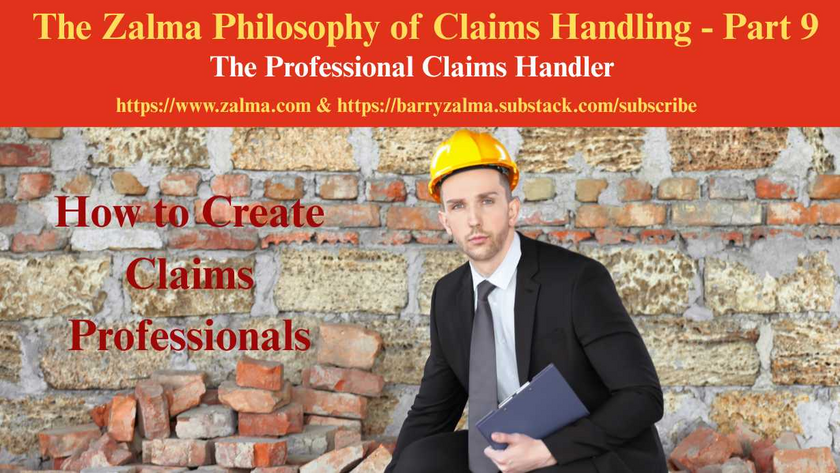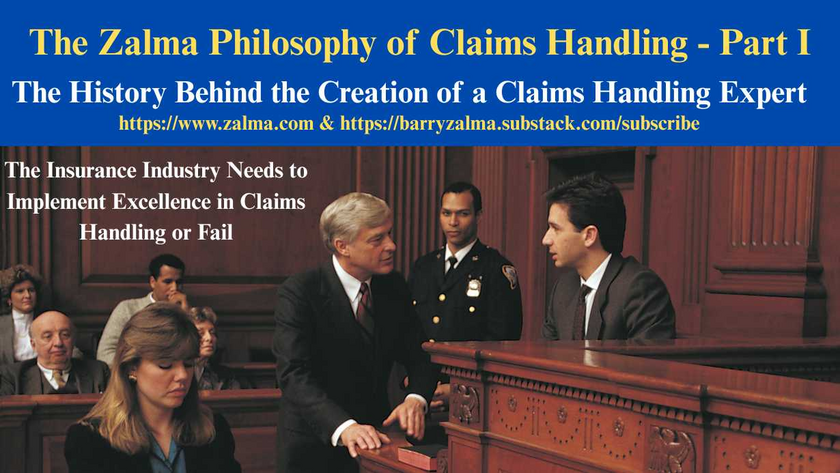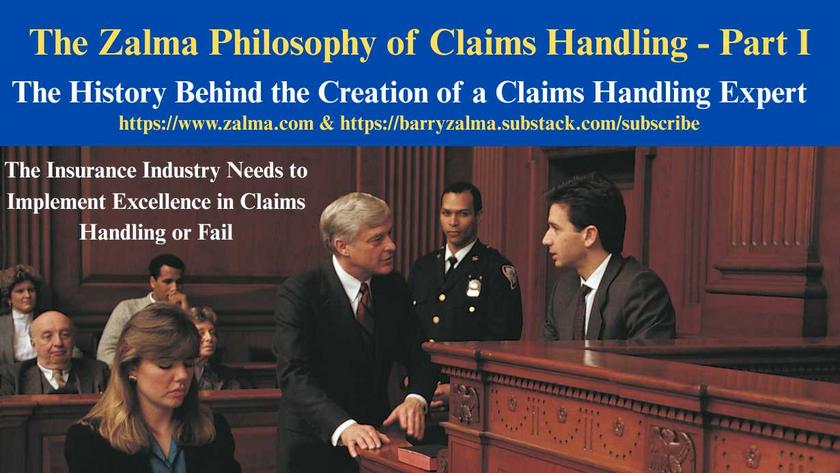
Ambiguous Policy Wording Results in Adoption of Continuous Trigger of Coverage
Barry Zalma
Nov 10, 2023
Read the full article at https://lnkd.in/gKZCZWdx and se the full video at https://lnkd.in/g6WKGvD6 and at https://lnkd.in/gTicqyji and at https://zalma.com/blog plus more than 4650 posts.
The United States Court of Appeals for the Fourth Circuit certified a question to the Supreme Court of Appeals of West Virginia asking: “[a]t what point in time does bodily injury occur to trigger insurance coverage for claims stemming from chemical exposure or other analogous harm that contributed to the development of a latent illness?”
In Westfield Insurance Company v. Sistersville Tank Works, Inc.; et al, No. 22-848, Supreme Court of Appeals of West Virginia (November 8, 2023) the Court answered the question. The Supreme Court answered the question with the conclusion that a “continuous-trigger” theory applies to the policy, as the policy is ambiguous as to when coverage is triggered.
The gateway to coverage under every standardized, commercial general liability (or “CGL”) policy issued in the United States since 1966 is proof that a bodily injury or property damage has “occurred.”
FACTUAL BACKGROUND
Sistersville Tank Works (“STW”) has, since late 1984, been a family-owned and -operated West Virginia corporation. STW manufactures, installs, and repairs various types of tanks at industrial sites throughout world, including at several chemical plants in West Virginia.
Beginning on the first day of 1985, STW was protected under a commercial general liability (“CGL”) policy it purchased from Westfield Insurance Company (“Westfield”), an Ohio corporation. Westfield thereafter renewed STW’s coverage under a series of CGL policies with one-year (or more) coverage periods. The CGL policy defines a “bodily injury” as a “bodily injury, sickness or disease sustained by a person, including death resulting from any of these at any time.”
At different points in 2014, 2015, and 2016, three men were diagnosed with various forms of cancer. In 2016 and 2017, the “claimants” (the men with cancer and/or their spouses) sued STW in three separate lawsuits in West Virginia state courts. The claimants alleged the cancers were, in some part, caused by STW’s tanks.
STW asked Westfield to provide a defense and indemnification to the three lawsuits under its previously purchased CGL policies. Westfield denied coverage under its CGL policies for the three suits and, in June 2018, filed a complaint against STW for declaratory relief and after discovery, the parties filed competing motions for summary judgment.
In an order dated September 4, 2020, the district court granted a judgment in favor of STW and found Westfield owed STW a duty to defend and to indemnify under all of its policies issued from 1985 through 2010. The district court concluded that Westfield’s promise to cover a bodily injury that “occurs during the policy period” was ambiguous in light of the latent disease claims asserted against STW. The district court ruled that the language in Westfield’s policy did not clearly identify when coverage was “triggered” in instances where a claimant alleged repeated chemical exposures and the gradual development of a disease over successive policy periods.
The Supreme Court had never addressed the question raised before the district court. Nevertheless, the district court calculated that this Court would apply the continuous-trigger theory to clarify the ambiguous language in Westfield’s policy.
DISCUSSION
Occurrence-based CGL policies provide coverage if the event insured against takes place during the policy period, irrespective of when a claim is presented. The certified question raises a different, more complicated set of circumstances. Westfield contends that manifestation of a disease is the sole trigger of coverage under its occurrence-based CGL policies.
On the other hand, STW takes the position that the occurrence language incorporates a “continuous” trigger theory of coverage. STW’s argument encompasses the entirety of Westfield’s insuring agreement. STW points out that, by definition, an “occurrence” under Westfield’s policy includes “continuous or repeated exposure” to a “harmful condition []” that results in “bodily injury, sickness or disease.”
It is evident from the parties’ competing positions that the meaning of the policy’s insuring agreement is uncertain or doubtful in the context of latent or progressive diseases, as the parties have shown the occurrence language used is susceptible to at least two plausible constructions. Here, the occurrence and bodily injury provisions that Westfield chose to incorporate into its insuring agreement fail to precisely articulate a trigger of coverage. They are, the Supreme Court concluded, ambiguous.
History shows that the “occurrence” language incorporated into the CGL policy was designed with the goal of affording coverage for singular, repeated, or continuous exposures to hazardous substances if those exposures cause either a singular or a progressive bodily injury, sickness, or disease. The Supreme Court concluded, after review of the history of the drafting of the CGL, that the drafters of the occurrence language used by Westfield intended to incorporate a continuous trigger of coverage.
The Policy Language Supports A Continuous Trigger
The reasoning of the Supreme Court’s recognition of the continuous trigger of coverage has the effect of spreading the risk of loss widely to all of the occurrence-based insurance policies in effect during the entire process of injury or damage. As one court said, the continuous trigger theory is the most efficient doctrine for allocation of liability amongst insurers for toxic waste cases, because it encourages all insurers to monitor risks and charge appropriate premiums.
Therefore, an occurrence based CGL policy covers all injuries, sicknesses, or diseases that occur during coverage, not merely those that become manifest.
Under the continuous-trigger theory, when a claim is made alleging a progressive injury caused by chemical exposure or other analogous harm, every occurrence-based policy in effect from the initial exposure, through the latency and development period, and up to the manifestation of the bodily injury, sickness, or disease, is triggered and must cover the claim.
ZALMA OPINION
It is axiomatic that when a court finds an ambiguity in an insurance policy it must be interpreted in favor of coverage for the insured. West Virginia found the policy was ambiguous as to trigger and therefore, overruling a strenuous dissent, and applied the continuous trigger expanding the coverages available to STW for the claims of the plaintiffs that STW was responsible for the illnesses because under the continuous-trigger theory of coverage every moment from the first exposure to the harmful chemicals up to and including the date of diagnosis would be covered by Westfield’s policy.
(c) 2023 Barry Zalma & ClaimSchool, Inc.
Please tell your friends and colleagues about this blog and the videos and let them subscribe to the blog and the videos.
Subscribe to Excellence in Claims Handling at locals.com at https://zalmaoninsurance.locals.com/subscribe or at substack at https://barryzalma.substack.com/publish/post/107007808
Go to Newsbreak.com https://www.newsbreak.com/@c/1653419?s=01
Follow me on LinkedIn: http://www.linkedin.com/comm/mynetwork/discovery-see-all...
Daily articles are published at https://zalma.substack.com.
Go to the podcast Zalma On Insurance at https://podcasters.spotify.com/pod/show/barry-zalma/support; Go to Barry Zalma videos at Rumble.com at https://rumble.com/c/c-262921; Go to Barry Zalma on YouTube- https://www.youtube.com/channel/UCysiZklEtxZsSF9DfC0Expg; Go to the Insurance Claims Library – http://zalma.com/blog/insurance-claims-library.
Please tell your friends and colleagues about this blog and the videos and let them subscribe to the blog and the videos. Go to Barry Zalma videos at Rumble.com at https://lnkd.in/gV9QJYH; Go to Newsbreak.com https://lnkd.in/gvDt8mBJ to substack at https://lnkd.in/gus8Mzkq; go to the Insurance Claims Library – https://lnkd.in/gwEYkxD
Refusal to Provide Workers’ Compensation is Expensive
Post 5240
Read the full article at https://lnkd.in/guC9dnqA, see the video at https://lnkd.in/gVxz-qmk and at https://lnkd.in/gUTAnCZw, and at https://zalma.com/blog plus more than 5200 posts.
In Illinois Department of Insurance, Insurance Compliance Department v.USA Water And Fire Restoration, Inc., And Nicholas Pacella, Individually And As Officer, Nos. 23WC021808, 18INC00228, No. 25IWCC0467, the Illinois Department of Insurance (Petitioner) initiated an investigation after the Injured Workers’ Benefit Fund (IWBF) was added to a pending workers’ compensation claim. The claim alleged a work-related injury during employment with the Respondents who failed to maintain workers’ compensation Insurance.
Company Overview:
USA Water & Fire Restoration, Inc. was incorporated on January 17, 2014, and dissolved on June 14, 2019, for failure to file annual reports and pay franchise taxes. It then operated under assumed names including USA Board Up & Glass Co. and USA Plumbing and Sewer. The business ...
Arsonist Incompetently Moves Pro Se to Avoid Prison
Post 5239
Read the full article at https://lnkd.in/gRX8TfKn, see the video at https://lnkd.in/gY3Jvnqp and at https://lnkd.in/gRCaaf-3, and at https://zalma.com/blog plus more than 5200 posts.
In Christopher A. Barosh v. Morris Houser, et al., Civ. No. 22-0769, United States District Court, E.D. Pennsylvania (November 25, 2025) a convicted arsonist and insurance fraudster moved the USDC acting in Pro se filed Objections to Magistrate Judge Reid’s Recommendation that the US District Judge dismiss his § 2254 Petition to avoid jail.
BACKGROUND
In October 2005, Barosh set fire to his girlfriend’s Philadelphia home — some 25 hours before the cancellation of the property’s insurance policy. Several witnesses saw Barosh leaving the property shortly before the fire erupted. After the fire, Barosh made “two separate admissions of guilt.”
He attempted to pay an acquaintance to provide him with an alibi for the time of the arson. The eyewitnesses, brother, and ...
Conditional Release Allows Supplemental Claims
Post 5238
Read the full article at https://lnkd.in/ge2yNQby, see the video at https://lnkd.in/gcSF9KWj and at https://lnkd.in/gQfJqwiM, and at https://zalma.com/blog plus more than 5200 posts.
A Release Should Totally Resolve Dispute
In Harvey et al. v. Hall, No. A25A1774, Court of Appeals of Georgia, Fourth Division (December 3, 2025) Paul Harvey, an employee of Arthur J. Dovers (d/b/a 3D Mobile Home Services), drove a truck towing a trailer loaded with machinery and equipment. Harvey fell asleep, veered off the road, and crashed into a culvert, causing Lamar Hall serious injuries.
FACTS OF SETTLEMENT
On August 18, 2020, Hall signed a limited liability release under OCGA § 33-24-41.1, releasing Harvey, Dovers, and their insurer (Georgia Farm Bureau Insurance Company) from liability for the accident in exchange for $50,000, “except to the extent other insurance coverage is available which covers the claim.”
Dovers’s general liability insurer (Republic-Vanguard ...
The Professional Claims Handler
Post 5219
Posted on October 31, 2025 by Barry Zalma
An Insurance claims professionals should be a person who:
Can read and understand the insurance policies issued by the insurer.
Understands the promises made by the policy.
Understand their obligation, as an insurer’s claims staff, to fulfill the promises made.
Are competent investigators.
Have empathy and recognize the difference between empathy and sympathy.
Understand medicine relating to traumatic injuries and are sufficiently versed in tort law to deal with lawyers as equals.
Understand how to repair damage to real and personal property and the value of the repairs or the property.
Understand how to negotiate a fair and reasonable settlement with the insured that is fair and reasonable to both the insured and the insurer.
How to Create Claims Professionals
To avoid fraudulent claims, claims of breach of contract, bad faith, punitive damages, unresolved losses, and to make a profit, insurers ...

The History Behind the Creation of a Claims Handling Expert
The Insurance Industry Needs to Implement Excellence in Claims Handling or Fail
Post 5210
This is a change from my normal blog postings. It is my attempt. in more than one post, to explain the need for professional claims representatives who comply with the basic custom and practice of the insurance industry. This statement of my philosophy on claims handling starts with my history as a claims adjuster, insurance defense and coverage lawyer and insurance claims handling expert.
My Training to be an Insurance Claims Adjuster
When I was discharged from the US Army in 1967 I was hired as an insurance adjuster trainee by a professional and well respected insurance company. The insurer took a chance on me because I had been an Army Intelligence Investigator for my three years in the military and could use that training and experience to be a basis to become a professional insurance adjuster.
I was initially sat at a desk reading a text-book on insurance ...

The History Behind the Creation of a Claims Handling Expert
The Insurance Industry Needs to Implement Excellence in Claims Handling or Fail
Post 5210
This is a change from my normal blog postings. It is my attempt. in more than one post, to explain the need for professional claims representatives who comply with the basic custom and practice of the insurance industry. This statement of my philosophy on claims handling starts with my history as a claims adjuster, insurance defense and coverage lawyer and insurance claims handling expert.
My Training to be an Insurance Claims Adjuster
When I was discharged from the US Army in 1967 I was hired as an insurance adjuster trainee by a professional and well respected insurance company. The insurer took a chance on me because I had been an Army Intelligence Investigator for my three years in the military and could use that training and experience to be a basis to become a professional insurance adjuster.
I was initially sat at a desk reading a text-book on insurance ...














